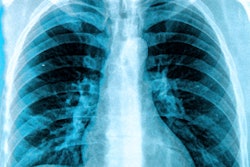
An artificial intelligence (AI) algorithm can automatically analyze pediatric x-rays to identify patients with incorrectly positioned catheters, potentially enabling these studies to be triaged for priority review by radiologists, according to research published online April 10 in the Journal of Digital Imaging.
Researchers from the University of Saskatchewan in Saskatoon, Canada, trained a deep-learning algorithm that yielded a promising level of performance for detecting and assessing placement of catheters and tubes. The resulting model achieved promising results for finding malpositioned catheters on pediatric chest/abdomen x-rays.
"In the future, an automated catheter placement evaluation system may also be used to prepopulate draft radiology reports with text describing the catheters and tubes present on an x-ray image," wrote the researchers, led by Xin Yi, PhD. "This may increase the efficiency of radiology reporting."
Catheters and tubes are commonly used during management of neonates who are critically ill or have low birth weight. However, these catheters are typically placed without real-time image guidance and are frequently malpositioned, which may result in serious complications, according to the researchers.
"An automatic approach is desired to flag x-rays which may have a malpositioned catheter so that they can be immediately reviewed by a clinician or radiologist, thus promoting safer use of catheters," the authors wrote. "Since the location of a catheter impacts clinical decision making, we believe detection of catheters is a critical first step towards a fully automatic catheter placement evaluation system."
Researchers trained a deep-learning algorithm to detect and assess the placement of all commonly seen catheters on pediatric x-rays by generating synthetic catheters on a random selection of 2,515 frontal-view images, which came from the U.S. National Institutes of Health Open-i adult chest x-ray dataset. Yi and colleagues then tested the algorithm on a dataset comprised of frontal chest/abdominal x-rays gathered at their institution on patients less than 4 weeks old. The test set included 35 images with different catheter types.
The researchers found that their algorithm could detect umbilical catheters, nasogastric tubes, and endotracheal tubes in less than one second on a PC with a single graphics processing unit. The algorithm achieved an F-beta score (the weighted harmonic mean of precision and recall) of 0.8.
Although they have only experimented with pediatric x-rays so far, the researchers said that they believe their methodology could also be suitable for analysis of adult x-rays, "provided the profile is carefully designed with consideration given to the large variation of catheter and wire types."
Their method may also help in the development of a system that can detect and assess the placement of catheters on x-ray images, facilitating triage and prioritization of images that show potentially malpositioned catheters for a radiologist's urgent review, according to the researchers.
Computer-aided evaluation of catheter placement is an emerging area of research, the team noted.
"It is our hope that this study can be beneficial towards building a general catheter placement evaluation system," Yi and colleagues wrote.




















